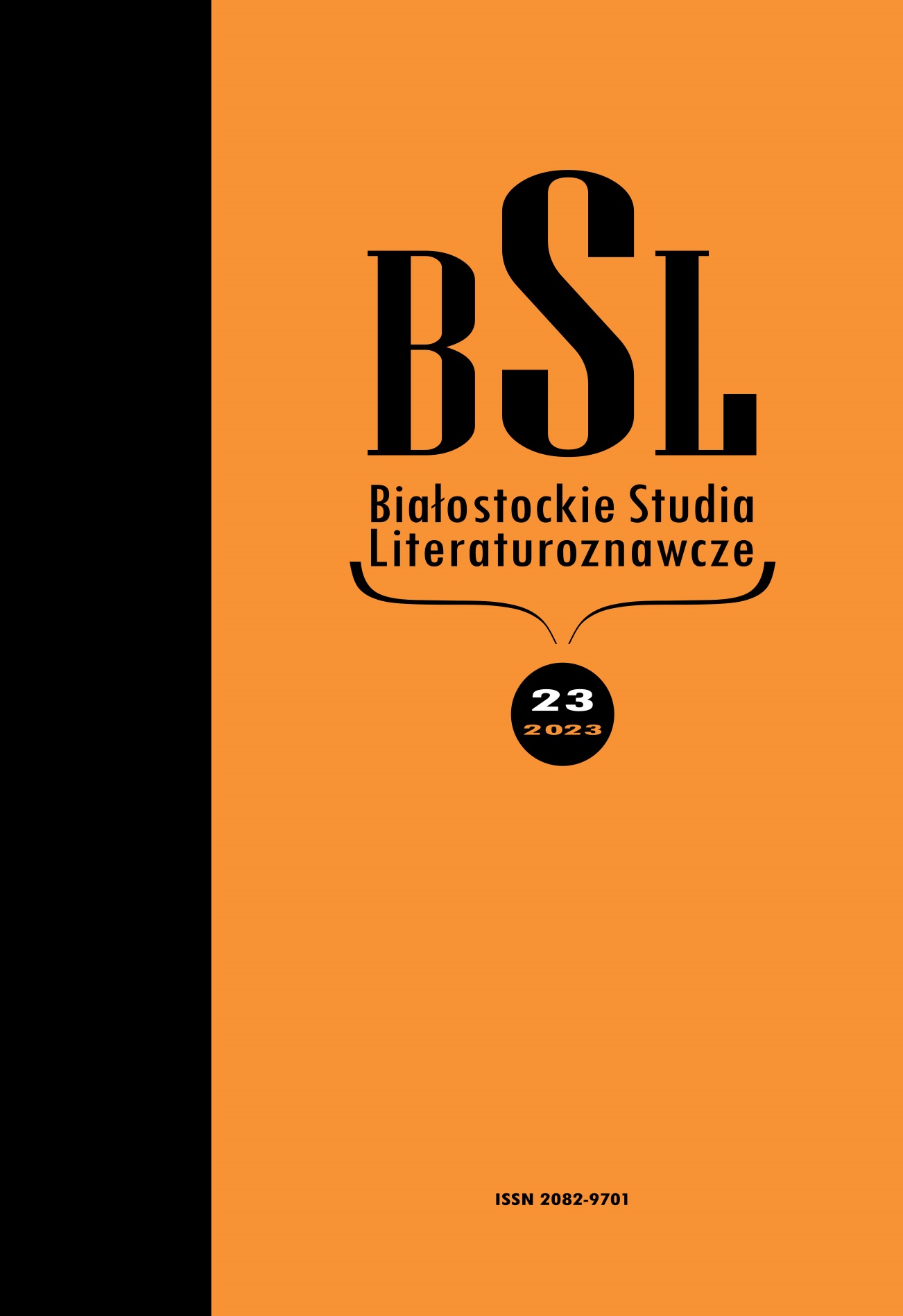In Perspective of Cultural Transformation. Economies of local landscapes through the lens of female film directors in Poland and Canada
Ilona Copik
Institut of Cultural Studies. University of Silesia in Katowicehttps://orcid.org/0000-0001-9794-9965
Abstract
This article analyses two documentary films: Angry Inuk (2016, directed by A. Arnaquq-Baril) and Gruba (2017, directed M. Zmarz-Koczanowicz). The author points out that local landscapes nowadays often become the focus of researchers' attention not only because they create a specific image of culture, but because they accumulate tensions related to the negative impact of traditional industrial structures on ecosystems. Traditional ways of sustenance, which for years have been the basis for the economic livelihood of local communities, are today fraught with irreconcilable contradictions and, as such, are highly controversial. While supporting small indigenous communities, the traditional lifestyles and social practices are at the same time entangled with ecological issues, animal rights and the concept of sustainable development. In the context of artistic expression, these issues are usually accompanied by ideas of social engagement and activism, which constitutes an essential point of reference for the author of this article. In film studies, the corresponding category is that of ‘participatory landscape’. The diverse cinematic geographies (Poland, Canada), whose background is on the one hand mining (Silesia), and on the other, the seal hunting industry (Nanavut), provide the basis for a comparative approach. This demonstrates how contemporary women from different latitudes create cinematic representations of local cultures, taking into account the tensions between the global and the local, the traditional and the modern, while proposing alternative images to those typical of mainstream global culture.
Keywords:
cinematic landscape, film anthropology, documentary cinema, lokality, women's cinemaReferences
Armata Jerzy (2015), Często myślę kadrem. Rozmowa z Marią Zmarz-Koczanowicz, „Magazyn Filmowy” nr 1 (41), s. 4–11.
Cole Susan G. (2016), Angry Inuk: Powerful doc slams seal hunt protesters, „New Toronto” https://nowtoronto.com/movies/angry-inuk-powerful-doc-slams-seal-huntprotesters/[dostęp 27.08.2024].
Copik Ilona (2018), Śląsk i kobieta. Filmowe przestrzenie kobiecej tożsamości, w: Filmowe przestrzenie Górnego Śląska, red. A. Gwóźdź, Katowice: Regionalny Instytut Kultury, s. 91–119.
Copik Ilona (2023), Film i krajobraz w perspektywie geografii kulturowej, „Prace Komisji Krajobrazu Kulturowego”, nr 49, t. 1, s. 89–110.
Dunlevy T’Cha (2017), Angry Inuk takes on anti-sealing crusaders, „Montreal Gazette”, https://montrealgazette.com/entertainment/movies/movie-review-angry-inuktakes-on-anti-sealing-crusaders [dostęp 27.08.2024].
Gibson Brian (2016), Angry Inuk, „Vue Weekly”, http://www.vueweekly.com/film/angry-inuk/ [dostęp 27.08.2024].
Green Joyce (2017), Taking More Account of Indigenous Feminism. An Introduction, w: Making Space for Indigenous Feminism, red. J. Green, Halifax-Winnipeg: Fernwood Publishing, s. 1–20.
Helphand Kenneth I. (1986), Landscape Films, „Landscape Journal”, nr 1, t. 5, s. 1–8.
Kermode Jennie (2017), Angry Inuk, „Eye for Film”, https://www.eyeforfilm.co.uk/review/angry-inuk-2016-film-review-by-jennie-kermode [dostęp 27.08.2024].
Maciejewski Łukasz (2009), Polska szkoła dokumentu. Maria Zmarz-Koczanowicz, „Machina”, nr 4, s. 111.
McKnight Brent (2017), Angry Inuk offers much to chew on, „Seattle Times”, https://www.seattletimes.com/entertainment/movies/siff-2017-highlights-of-the-filmfestivals-second-week/ [dostęp 27.08.2024].
Mullen Pat (2016), Angry Inuk, „Point of View Magazine”, https://povmagazine.com/review-angry-inuk/[dostęp 27.08.2024].
Lefebvre Martin (2006), Introduction, w: Landscape and Film, red. M. Lefebvre, New York: Routledge, s. xi–xxxi.
Lubuskie Lato Filmowe 2017 – Spotkanie z Marią Zmarz-Koczanowicz po projekcji filmu Gruba, https://www.youtube.com/watch?v=wQPTBJ GmrY [dostęp 27.08.2024].
Piepiórka Michał (2017), Krakowski Festiwal Filmowy #2 – z przeszłości, teraźniejszości i przyszłości, „Bliżej ekranu”, http://blizejekranu.pl/krakowski-festiwal-filmowy-2-z-przeszlosci-terazniejszosci-i-przyszlosci/ [dostęp 27.08.2024].
Q&A with Alethea Arnaquq-Baril – Angry Inuk, Concordia University, Montreal, 12.12.2016, https://www.youtube.com/watch?v=nPVxtVZGkss [dostęp 27.08.2024].
Sauter Marcin, Cuske Maciej, BKF Masterclass, Spotkanie z Marią Zmarz-Koczanowicz, Bydgoska Kronika Filmowa i Kino Orzeł, https://www.youtube.com/watch?v=2mw1MNUdIGI [dostęp 27.08.2024].
Twórcy: Maria Zmarz-Koczanowicz, „Culture.pl”, 05.08.2020, https://culture.pl/pl/tworca/maria-zmarz-koczanowicz [dostęp 27.08.2024].
Wheeler Brad (2016), Doc challenges well-funded anti-sealing campaigners, „Globe and Mail”, https://www.theglobeandmail.com/arts/film/film-reviews/angry-inukdoc-challenges-well-funded-anti-sealing-campaigners/article32547238/ [dostęp 27.08.2024].
Wroński Michał (2015), O „grubie”, o Śląsku i o górniczym życiu. Powstanie film o kobietach pracujących na kopalniach, „Dziennik Zachodni”, 03.04.2015.
Institut of Cultural Studies. University of Silesia in Katowice https://orcid.org/0000-0001-9794-9965
License

This work is licensed under a Creative Commons Attribution-ShareAlike 4.0 International License.
Articles published on the platform of Białostockie Studia Literaturoznawcze are available under the license CC-BY-SA 4.0 (CC Attribution-ShareAlike 4.0).
All interested parties have access to the published articles under the following conditions:
1.They must acknowledge authorship, which means crediting the author, title, source, together with the disseminated work (including the hyperlinks to the original work and doi) as well as the same license under the same conditions.
2. Derivative works can be distributed only under the same license as the original work.
The University of Białystok retains the right to the entire journal (layout, graphic design, title, cover design, logo, etc.).
The author retains the property right but confers on the University of Białystok the right to use the work.



